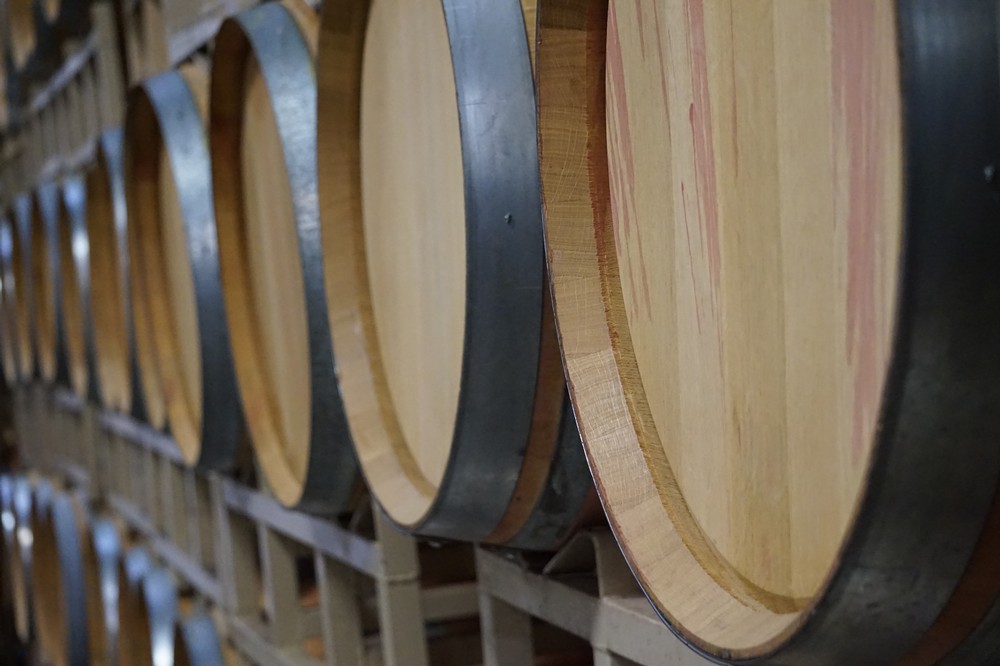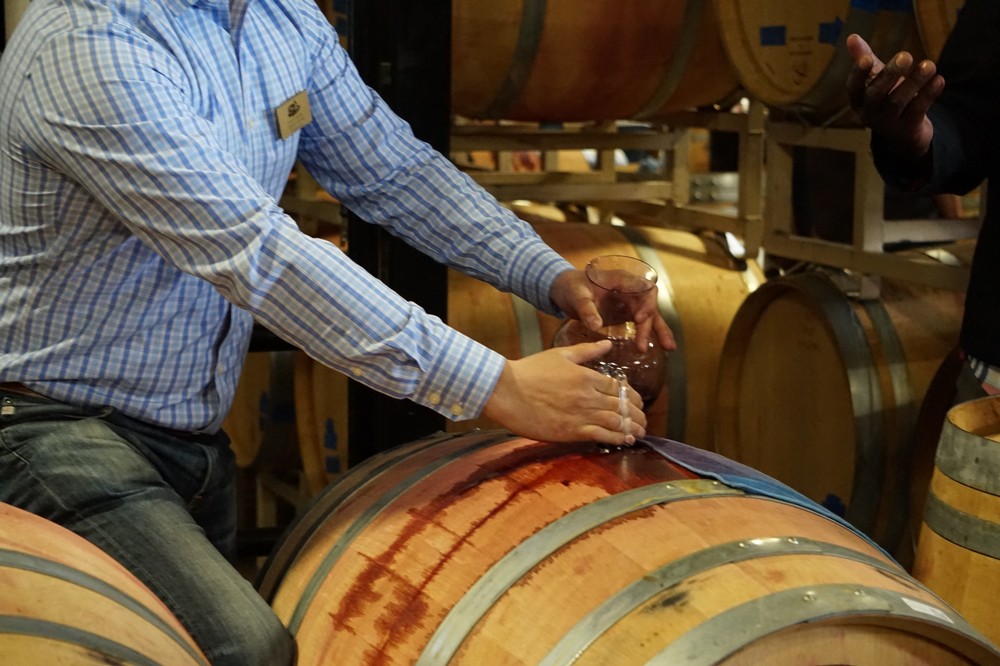DeLille Cellars Blog
The Journey of a Barrel
Oak barrels play an essential role in winemaking, from renowned Cabernet Sauvignon of Napa Valley to acclaimed Bordeaux-style blends of Washington State. Oak adds flavor compounds, slows oxygen intake (helping the wine taste smoother), and provides an ideal environment for malolactic fermentation (contributing “creaminess” to the wine). But what happens to barrels when they reach the end of their useful life at the winery?
For the barrels used at our Woodinville winery, DeLille Cellars is just a stop along the way. Let’s explore the journey of a barrel - from soil to cooperage to local artisans in the Pacific Northwest.
From Forest to Barrel
The journey of the barrel begins in the forest. Terroir plays an important factor here, just as it does in the vineyards. The location of the tree, how slowly it grew, and age are all factors taken into consideration. Slow growth oak trees contain tighter grain, thus providing better quality oak for barrels.
The specific barrel we’ll be following is sourced from Seguin Moreau, a French cooperage headquartered in Merpins, France. With nearly two centuries of experience, the cooperage has been pioneering oenological research and producing top-quality barrels since 1838.
Harvesting
Once selected, the wood is cut into staves that are slightly angled. The staves will “season” outside for 2-3 years, allowing the wood to lose verdancy and leech out raw and recognizably ‘woody’ flavors.
Cooperage
After the wood is harvested, the barrel maker, or cooper, gets to work. The barrel must be watertight without glue, thus requiring adroit work from skilled coopers. The staves are fit tightly together with a metal hoop as the barrel begins to take its shape.
DeLille Cellars
With over 20 Rhône and Bordeaux-style wines in our portfolio, our winemaking team utilizes different styles of barrels depending on the style and varietal. DeLille purchased these specific barrels in 2018 and filled them with Cabernet Sauvignon Clone 8 from Upchurch Vineyard located on Red Mountain.
Clone 8 originates from Château Margaux in Bordeaux, France, and was introduced to California vineyards in 1893. It is the most widely planted Cabernet Sauvignon clone in Washington State and is known for reflecting the unique terroir of the vineyard site.
Dark fruit notes dominate Grand Ciel Clone 8, while Clone 8 from Upchurch Vineyard offers flavors of red fruit with dark highlights. In 2021, the barrels had served their purpose at DeLille and the Cabernet Sauvignon was emptied for blending into Four Flags, Doyenne, and D2.
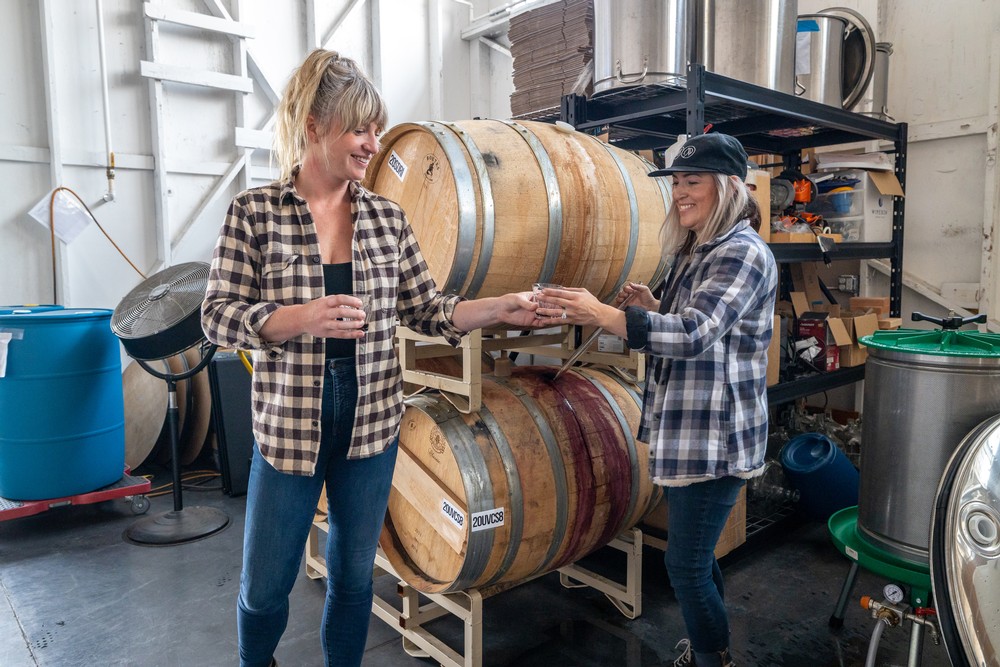 Fast Penny Spirits Founders Holly Robinson and Jamie Hunt; Photo by Kristopher Shinn
Fast Penny Spirits Founders Holly Robinson and Jamie Hunt; Photo by Kristopher Shinn
The Journey Continues: Fast Penny Spirits
The barrels were then passed onto Fast Penny Spirits, a locally woman-owned and operated amaro distillery. Blended with a combination of the highest-quality, organic, and consciously sourced botanicals, Fast Penny utilized the DeLille Cellars’ barrels to rest a limited release amaro which will be available first to the Veloce Society club.
Italian for bitter, amaro is an herbal liqueur made from infusing a base spirit with herbs, roots, flowers, bark, and citrus. For Fast Penny, that spirit is grape-based, which follows Italian tradition. After macerating, the amaro rests in a combination of stainless and wood. For the limited release, Fast Penny Spirit’s Amaricano was rested in DeLille Cellars' barrel for four months, allowing for the oak to impart on the amaro, highlighting notes of wood, cocoa nibs, tar, and adding depth.
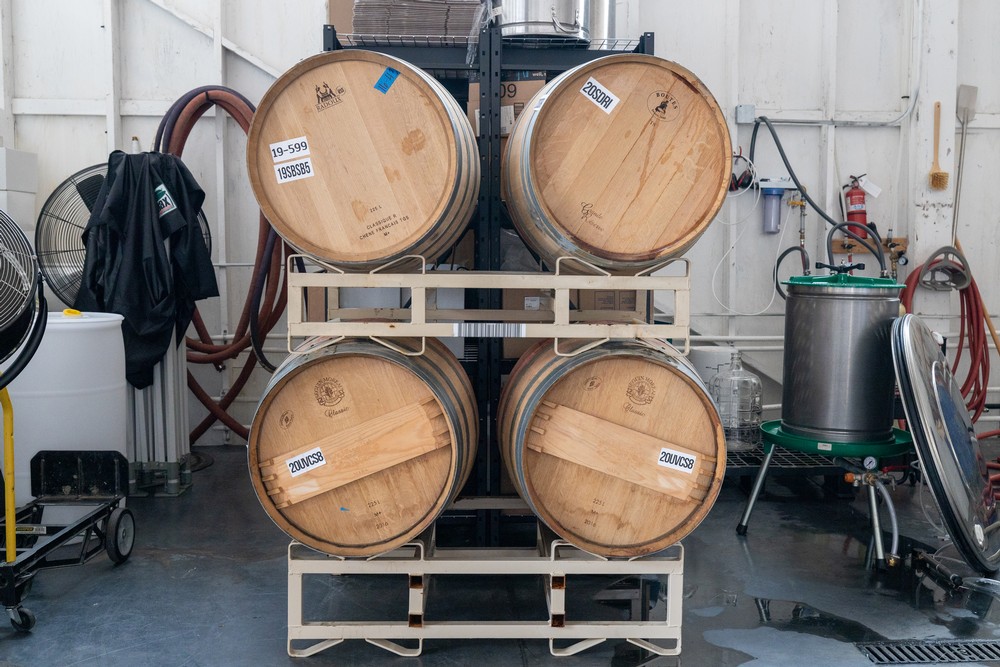 DeLille Cellars barrels at Fast Penny Spirits; Photo by Kristopher Shinn
DeLille Cellars barrels at Fast Penny Spirits; Photo by Kristopher Shinn
The Final Destination: Fair Isle Brewing
Finally, the barrels are passed on to Fair Isle Brewing in Ballard. Fair Isle is a brewery rooted in intention and focuses on creating purposeful farmhouse ales that reflect the Pacific Northwest. Here, the oak barrels will contribute subtle oak flavor to Fair Isles’s hand-crafted farmhouse ales.
Oak is an integral part of brewing at Fair Isle. In fact, the team views oak as an ingredient of the beer rather than just a vessel. Like yeast, oak barrels are a living environment of bacteria and microorganisms and allow the brewers to achieve levels of complexity in beer otherwise unattainable in stainless steel tanks. When selecting a barrel, the team looks for ideal characteristics of the microflora and oak that will impart specific flavors to the beer.
After acquiring the barrels of freshly emptied Amaro from Fast Penny Spirits, the team at Fair Isle filled them with beer. Since October, the beer has been maturing in the oak, soaking up herbal notes and remnants of the Amaro the barrel previously held. The team recently sampled the contents and is excited about the results thus far. A Flemish-style Saison is aging in the Amaricano barrels and a more traditional, pale Saison is aging in the Amaricano Bianca barrels. “We are excited to see these beers continue to develop as we get ready to package them next month for our bottle membership,” said Matt Rowe, Brewer at Fair Isle.
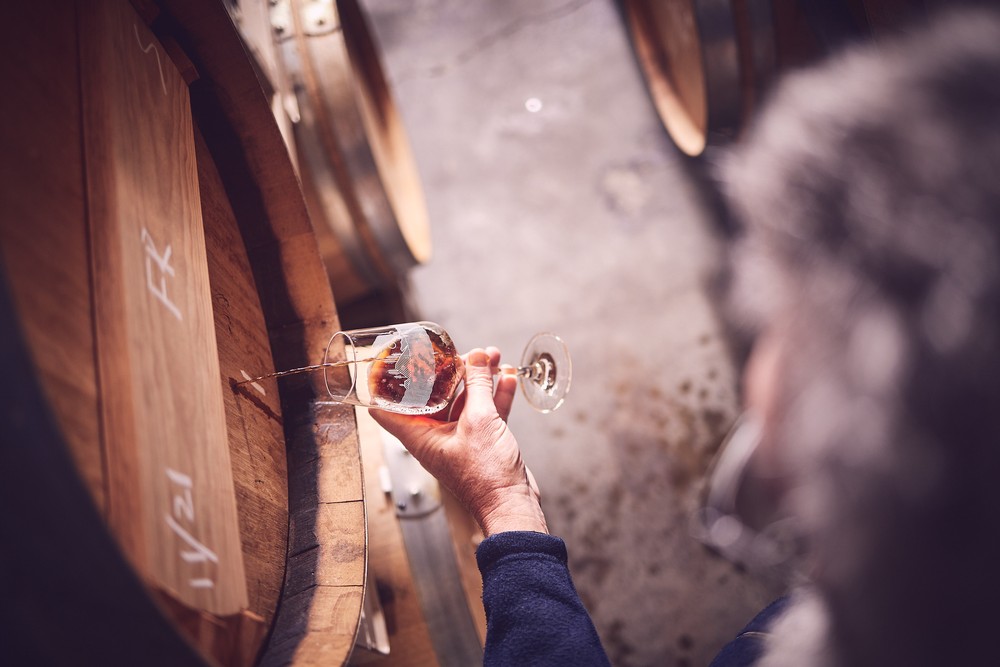 Geoffrey Barker, Co-Founder at Fair Isle Brewing “pulling a nail” on the barrel that had previously housed DeLille Cabernet Clone 8 and Fast Penny Amaricano
Geoffrey Barker, Co-Founder at Fair Isle Brewing “pulling a nail” on the barrel that had previously housed DeLille Cabernet Clone 8 and Fast Penny Amaricano
About DeLille Cellars
DeLille Cellars is the third oldest operating winery in Woodinville, WA, founded in 1992. Known for pioneering Bordeaux-style blends from Washington State, the winery has maintained a tradition of quality and excellence with over 700 individual 90+ ratings from leading publications. DeLille Cellars focuses on the Red Mountain AVA and sources grapes from Washington’s most acclaimed vineyards. The winery is recognized by notable wine critics and influencers, including Robert Parker, as one of the top producers in the state.
About Fast Penny Spirits
Fast Penny Spirits is a woman-owned and operated award-winning amaro distillery. Based in Seattle and inspired by the founder’s Italian heritage, the company is committed to stirring up change. Blended with a combination of the highest-quality, wild-crafted, organic, and consciously sourced botanicals, Fast Penny’s spirits are rich, herbaceous, and captivating. Luxurious and refined, their Italian-style amari - Amaricano and Amaricano Bianca - are beautifully complex to sip on their own or swirl into a cocktail. With a constant eye on environmental impact and a 3% Pretty Penny give-back program, Fast Penny Spirits is dedicated to supporting and empowering women, local communities, and the hospitality industry.
About Fair Isle Brewing
Fair Isle is a brewery in the Ballard Neighborhood of Seattle creating farmhouse beers rooted in the Pacific Northwest. Today, farmhouse beer doesn't have to be brewed on a farm; its more about a mindset and respect for its origins. It’s about embracing variation rather than avoiding it. We like to think of ourselves as shepherds rather than controllers - giving our fermentation cultures the time they need to make great beer.
DeLille Cellars Harvest 2021 Recap
Tuesday, October 12th marked the last day of harvest at DeLille Cellars. “I think it’s going to be a really, really fantastic vintage,” said Jason Gorski, Director of Winemaking and Viticulture.
Warm weather, smaller than average berry size, lower than average crop loads, and incredible color and flavor are a few characteristics that differentiated this year’s harvest.
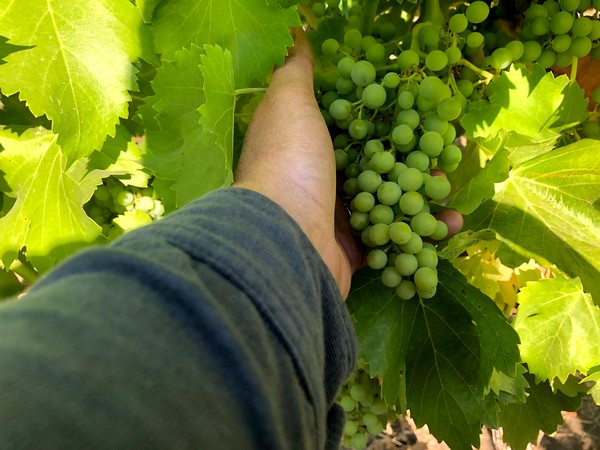
Grenache from Boushey Vineyard, Washington. July 2021. Photo Credit: Jason Gorski
2021 Harvest Brings Record Heat
“We did have one of the warmest vintages on record this year. The vines are able to adapt to that in a way - our growers did a great job of keeping canopies popped up. I actually saw less shrivel in 2021 than we saw in either 2013 or 2015,” Jason Gorski noted.
Climate researcher Greg Jones commented that the 2021 vintage in the Pacific Northwest leaned more toward the historically hot 2015 growing season than last year.
The Crew
Our 2021 harvest would not have been successful without our amazing winemaking team and our interns this year.

2021 Harvest Team
“This year we had an absolutely incredible harvest crew - probably the best I’ve ever had the opportunity to work with. They had a good sense of humor and a smile on their face no matter what happened. It makes it a lot easier when you have people along for the ride that enjoy that chaos,” said Jason Gorski.
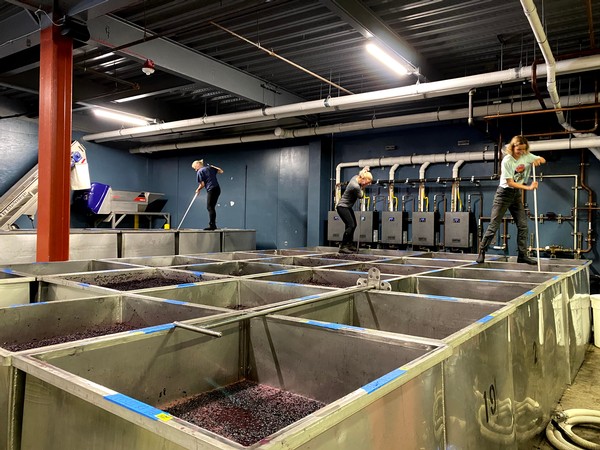
Fast & Furious Timeline
One of the challenges of this years’ harvest was the condensed timeline.
Gorski said, “We normally have about three months to do harvest but this year we got everything done in about 10 weeks. It was fast and furious with the lower yields at a faster than average pace.”
Dick Boushey of Boushey Vineyards, an important producer of Syrah used in our Doyenne, also commented “this has been the most chaotic, frantic harvest I have ever been involved with. Everything seems to have gotten ripe at once. We have been working almost around the clock” (Wine Searcher).
Looking to the Future
Partially through harvest, DeLille Cellars expanded production by adding several concrete eggs and new fermentors. “We’ve been wanting to work with concrete for a really long time at DeLille, but it’s not very cost-effective or space-efficient but with that additional space we put in a few concrete eggs,” reported Gorski. These eggs will be used for Sauvignon Blanc, Semillon, and Roussanne.
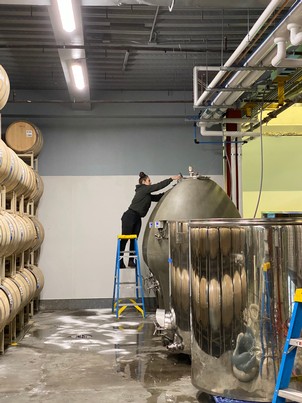
Assistant Winemaker Mari Rossi checking a concrete egg fermenter
“Global logistics are a bit of a mess right now but we’ll have some more upright [tanks] showing up just as harvest ends. Unfortunately, we were hoping to fill those by now,” Gorski said. These tanks will hold (what will become) 2021 D2.
The team also commented on the stark color intensity of the 2021 vintage. While this doesn’t necessarily translate to anything specific, it was remarkable to see the deep, dark colors.
Jason Gorski summed up harvest by stating, “Every vintage is an opportunity to be great no matter how challenging it is and what the conditions give you. Our goal is to make nothing but world-class wine.”
Watch the full interview with Jason Gorski below.
From Two Grand Crus to Washington State – Crafting the Most Acclaimed White Bordeaux-Style Blend in America
For many years, Chaleur Blanc has been a favorite among wine enthusiasts, connoisseurs, and collectors. The white Bordeaux-style blend is a world-class Washington wine that showcases traditional French blending techniques with the unique terroir of Washington state. Wine critic Stephen Tanzer exclaimed, “it is no exaggeration to compare this Sauvignon Blanc/Sémillon blend to the finest white Bordeaux bottlings made in oak”. He described the blend as an “utterly distinctive wine for Washington in terms of its texture, purity, complexity, savory character and ageability”.
Since its first vintage in 1995, Chaleur Blanc was served at the White House over three administrations and has become one of DeLille’s most beloved and influential blends.
Pioneering Washington State’s First White Bordeaux-style Blend
DeLille Cellars was founded in 1992 and pioneered two red Bordeaux-style blends, Chaleur Estate and D2. These wines were produced with a focus on Red Mountain and showcasing the premier fruit of acclaimed vineyards in the Columbia Valley. In 1994, DeLille crafted another Bordeaux blend, Harrison Hill, from a historic vineyard located in the Snipes Mountain AVA, a sub-appellation of Yakima Valley, which itself is a sub-appellation of the larger Columbia Valley.
With three red blends gaining international notoriety from key critics, including Robert Parker Jr., the winery sought its next feat of French inspiration via white wine. California Chardonnay was already saturating the market, and Chris Upchurch, Founding Winemaker at DeLille, knew the winery had a calling to produce the first white Bordeaux-style blend in Washington State.
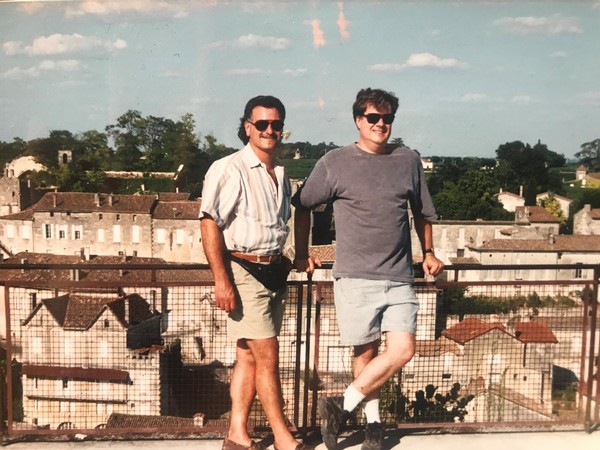
Seeking Inspiration from the Source: A Journey to Bordeaux
Chris Upchurch had previously interned with David Lake, Master of Wine at Columbia Winery in Woodinville, Washington. Lake served as DeLille’s consultant in the winery’s formative years and made remarkable connections at some of Washington’s most renowned vineyards, including Ciel du Cheval, Red Willow, and Harrison Hill.
In 1995, Lake contacted prominent old-world wineries Château Haut-Brion and Château Margaux for Chris Upchurch and Founding Partner Jay A. Soloff to visit, creating a foundation for one of DeLille’s most esteemed wines to come to fruition. Jay also had many relationships in Bordeaux from his prior years as a wine broker.
With a notepad and a list of contacts in France, Chris and Jay set off on a pilgrimage to find DeLille Cellar’s next wine: the first white Bordeaux-style blend to be produced in Washington State.
Château Bellegrave
First, Chris and Jay visited Château Bellegrave in Pauillac. They sought the expertise of a small Entre-deux-Mers wine producer who revealed the basics of crafting white Bordeauxs. The founders of DeLille were told, “cold soak, don’t ferment on the solids.” Here they learned a secret to the Bordeaux-Blanc recipe which this small winemaker called interfacing. The only way to perfectly interface is to cold soak the grapes and then ferment them in a barrel. After racking off solids into barrels, the wine barrel ferments, allowing for a creamy, refined wine.
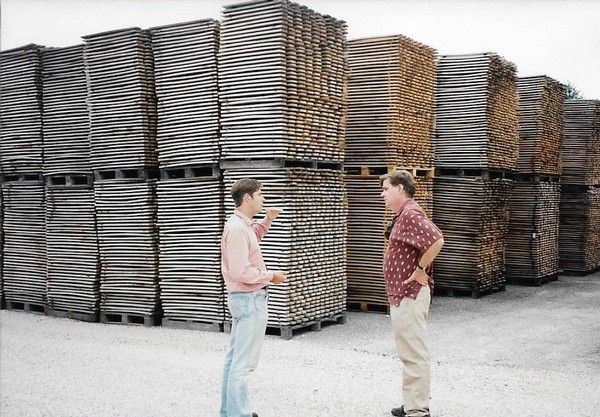
Chris Upchurch with a Bordeaux Barrel Maker
Château Haut-Brion
The following days were filled with adventures that most winemakers can only dream of. Chris and Jay spent the day with Jean Philippe Delmas at Château Haut-Brion, one of the most famous wineries in the world. It is the only Bordeaux winery with Grand Cru classification for a white blend, crafted before 1855 when the classification was established.
Delmas confirmed everything Chris and Jay had learned so far on their journey. The renowned Bordeaux winemaker walked the DeLille founders through winemaking techniques of Bordeaux whites and explained how the conditions of climates such as Bordeaux, France, and the Columbia Valley in Washington State favor Sauvignon and Sémillon grapes. Cooler, dry vintages tend to pick up characteristics from gravelly clay soils, while still maintaining crisp “nectarine-like” qualities of the Sauvignon and honeysuckle and creme brulée of Sémillon.
Château Margaux
Chris and Jay then traveled to Château Margaux where they met with Paul Pontellier, a prominent winemaker in the region. Here, they also learned of Bordeaux white techniques and tasted reds that were in the process of barrel aging.
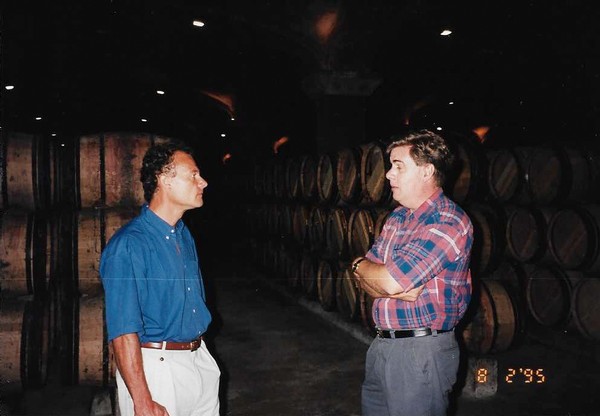
Chris Upchurch with Paul Pontallier at Château Margaux
While visiting the chateau, the winemakers tasted Château Margaux Pavillon Blanc, a blend that received the winery’s “deuxieme,” or second wine classification, because production began after the 1855 classification. They also visited Domaine de Chevalier and Chateau Oliver.
Creating DeLille’s Fourth Wine: Chaleur Blanc
Upon returning to Washington State, Jay and Chris immediately ordered a proper winemaking tank. Lake helped them source an old milk tank, and then the winemakers began the process of “interfacing”, with cold soaking followed by barrel fermentation. Jay told Chris, “If it’s good enough for Château Haut-Brion, it’s good enough for DeLille.” Jay A. Soloff recalls, “We were that innocent to believe that we could make a world-class white Bordeaux-style blend in Washington”.
Chaleur Estate Blanc, now renamed Chaleur Blanc, is a product of the time Delmas and Pontellier spent with two young winemakers from Washington State. The esteemed wine lends its name from the shortened version of “chaleureux,” meaning warm and hearty, which is how co-founder Greg Lill described the grounds that would soon become DeLille Cellars’ winery and offices. In 2019, DeLille Cellars moved to the Old Redhook Brewery in the Hollywood District of Woodinville.
Crafting a white Bordeaux-style blend was unheard of in Washington State until 1995 when the first vintage of Chaleur Blanc was released. The wine is fermented sur-lie on the spent lees and also battonage, imparting a memorable “crème brulee” finish”. The lees are also stirred in the barrel each week. Chaleur Blanc is both a remarkable accomplishment to new world Bordeaux-style blends and Washington State wine, the second-largest wine-producing state in the US.
Updating the Aging Chart
On the 22nd of March, 2021, the DeLille winemaking team assembled to taste and evaluate a considerable number of wines from past vintages, with the primary goal of updating the aging chart. The obviously wonderful side effect, of course, is that we had the opportunity to taste some absolutely delicious older wines! The challenge for us as winemakers is to constantly improve, and that evolution is impossible without understanding the foundation of our style, and how that style has subtlety changed over time to keep pace with consistent improvement in the vineyard, with fine tuning in the cellar.
The actual tasting process involved several vertical tasting flights of several vintages of individual wines. The purpose of a vertical tasting is to isolate vintage variation as the most significant variable, and to better understand the evolution of the wines as they age in bottle. Although vertical flights can be tasted youngest to oldest, we elected to taste the older wines first, and started with Rhone varietals; the daunting number of wines on the table made it apparent that palate fatigue from accumulating tannin would come into play.
All the selected wines were turned upright several days prior to the tasting to let them settle and stored in one of our barrel rooms to ensure the temperature of each wine was consistent. Despite the volume of bottles and significant age, we only had a single bottle that suffered from a cork fault (an older vintage, the cork had lost its seal at some point). We pulled two bottles of each wine in preparation, so we were still able to evaluate the wine.
Each bottle was opened and immediately poured to eliminate the variable of exposure to oxygen. We had a Durand wine opener on hand in case we ran into a particularly delicate closure, but an Ah So proved to be capable enough for each bottle.
In terms of the evaluation of the individual wines, we all took copious notes on each wine within the vertical, and then openly debated the status of each wine on its individual aging trajectory. When a wine tastes best on this trajectory is subject to the opinion of every taster. For the sake of our aging chart, we use the following definitions:
HOLD wines exhibited only primary aromas and flavors - delicious to drink now, but certain to improve for some time.
DRINK/HOLD wines exhibited some secondary aromas and flavors associated with aging - time in the bottle has developed and improved the wines beyond their infancy, and further aging will continue to benefit the wine.
DRINK wines exhibited some tertiary aromas and flavors - drinking beautifully, and likely to continue to do so for several years, but likely at their very peak of enjoyment.
MATURE wines showed their age - individual bottles may be drinking well, but certainly should be consumed, as further aging will not improve their quality.
DeLille Cellars Announces New Director of Winemaking
NOTABLE WASHINGTON WINERY DELILLE CELLARS ANNOUNCES NEW DIRECTOR OF WINEMAKING
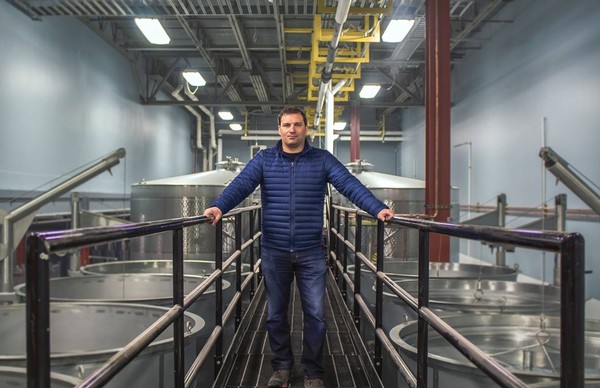 Caption: DeLille Cellars’ new director of winemaking and viticulture, Jason Gorski, standing in the winery’s brand-new production facility at the old Redhook space (credit: DeLille Cellars)
Caption: DeLille Cellars’ new director of winemaking and viticulture, Jason Gorski, standing in the winery’s brand-new production facility at the old Redhook space (credit: DeLille Cellars)
WOODINVILLE, Wash. (January 22, 2019) – DeLille Cellars, one of Woodinville’s founding wineries and a prominent player in developing Washington State as a premier wine region, today announced that Jason Gorski has been promoted to director of winemaking and viticulture. Gorski previously served as winemaker and assistant winemaker, under the tutelage of founding winemaker Chris Upchurch.
Gorski has been instrumental in DeLille Cellars’ success since joining its winemaking team in 2011. He has helped expand production from just over 10,000 cases to nearly 30,000 and has improved its quality, having been involved with 239 of the 90+ scores DeLille has received.
“Jason has built a great winemaking team and possesses a unique ability as a very talented winemaker with unrivaled technical skill,” said Tom Dugan, DeLille’s CEO. “Along with [co-presidents] Chris [Upchurch] and Jay [Soloff] and the rest of our owners, we’re incredibly excited for the next chapter of DeLille, with Jason at the helm of winemaking.”
Every wine DeLille has produced since 2011 has received at least one 90+ score from the top four international critics, leading the winery to over 500 individual 90+ ratings since its founding. DeLille received a coveted position on the Wine Spectator Top 100 list in 2018 with its 2015 Signature Syrah (Gorski’s third such honor), as well as two consecutive Wine & Spirits “Top 100 Wineries of the World” awards (in both 2017 and 2018), along with numerous national and local accolades under Gorski’s leadership. These include the Seattle Times #2 wine of the year in 2017 and #1 wine of the year in 2018, plus the Wine Press Northwest Washington Winery of the Year in 2017.
“Established with a focus on wine quality, DeLille Cellars is an integral part of the history of Washington wine and its increasing reputation throughout the world,” said Gorski. “I look forward to continuing to build upon that foundation, working to continuously improve our wines and promote the excellence of Washington vineyards.”
Gorski found his passion for wine while studying biology at Duke University. He was introduced to a respected sommelier by his academic advisor and eventually moved to Washington State in 2004, where he worked at the state’s founding winery, Chateau Ste. Michelle, in Woodinville. He was then offered the role of assistant winemaker at Spring Valley Vineyard in Walla Walla, Washington, before beginning at DeLille in 2011.
Gorski’s promotion aligns with DeLille’s recently announced acquisition of the former Redhook Brewery space. The winery plans to have all production moved to and operational in its new home by the end of January. Gorski has managed the process of refurbishing the original brewery tank room into a world-class production facility. The next phase will include construction of a new three-story tasting room and retail tower, to be completed in late summer of this year.
With Gorski’s promotion, Upchurch will take on a modifiedrole but remain as co-president, partner and founding winemaker. He will continue to be actively involved, supporting Gorski and the winemaking team with harvest and blending, as well as helping to guide the company’s goals from an ownership perspective. He plans on focusing his efforts on supporting the national sales program and continuing to be present at retail events.
“I have been at the forefront of DeLille’s winemaking for the last 27 years, and am extremely proud of what we have created. Our acquisition of a world-class facility at Redhook provides the perfect opportunity for me to scale down as the winery looks to the future,” said Upchurch. “Jason’s well-deserved promotion to director of winemaking recognizes his incredible contributions to DeLille and his passion for continuing our great legacy.”
# # #
About DeLille Cellars
Founded in 1992 by Jay Soloff, Chris Upchurch and Charles and Greg Lill, DeLille Cellars is a boutique artisan winery located in Woodinville, Washington. Known for pioneering Bordeaux-style blends from Washington State, the winery has maintained a tradition of quality and excellence, with over 500 individual 90+ ratings from leading publications. DeLille Cellars focuses on the Red Mountain AVA and sources grapes from Washington's most acclaimed vineyards, including Ciel du Cheval, Grand Ciel, Upchurch, Red Willow, Sagemoor, Klipsun, Boushey and Harrison Hill. The winery is recognized by notable wine critics and influencers, including Robert Parker, as one of the top producers in the state. To learn more about DeLille Cellars, visit www.delillecellars.com.
MEDIA CONTACT
Tracy Rabsky
Public Relations, GreenRubino for DeLille Cellars
P: 206-452-8185
E: tracyr@greenrubino.com
Sign Up For Our Newsletter
Keep up to date on the latest wine releases, events, and promotions.
